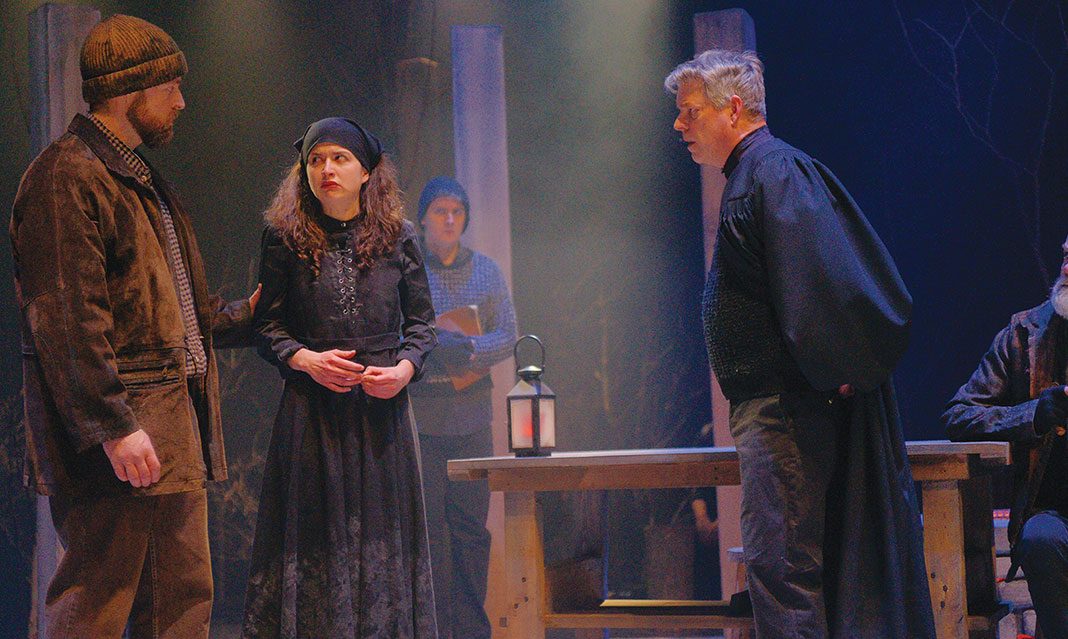In Massachusetts lies a town called Salem, well-known in pop culture for the infamous 17th century witch trials. The Crucible’s premier on January 19 marks Arthur Miller’s tale of witchcraft as Hart House Theatre’s third production of the season. Under the direction of Michael Rubinstein, the play’s undercurrent themes of secrecy, lies, and mystery were brought to the forefront.
“The Crucible is a tale of caution that warns of the deadly consequences when a society allows fear, suspicion, and superstitious gossip to rule over facts and reason,” reads Hart House’s broad online description of the play.
Published in 1953, Miller’s semi-fictionalized tale is set in a Puritan town. When Reverend Samuel Parris (Anthony Botelho) discovers his daughter Betty (Abigail Craven), his niece Abigail Williams (Courtney Lamanna), and other town girls dancing in a forest, he immediately suspects witchcraft. Upon discovery, Betty fades in and out of consciousness throughout act one of the play.
Upon returning with news of possible witchcraft, Parris unsettles the rest of Salem with the foreboding revelations. Amidst the uproar, Abigail finds herself alone with John Proctor (Jon Berrie)—the man with whom she develops an affair, while employed as a servant in his household. Abigail assures John that she did not commit witchcraft. What follows is an explosive series of events that involve Elizabeth Proctor’s (Melissa Taylor) tumultuous relationship with her husband, Reverend Hale’s (Nicholas Koy Santillo) intervention in the trials, and Mary Warren’s (Nina Rose Taylor) imprisonment. All these events, coupled with accusations of witchcraft weighing heavily on Abigail and the rest of the girls, cultivate an atmosphere of distrust among the residents of Salem.
Taylor’s portrayal of Elizabeth’s growing tension with her husband was moving. When John confesses in order to placate the town’s need for scapegoats, Elizabeth shares an emotionally-charged moment with her husband. In this scene, Taylor’s expression is one of melancholy—suggesting that, perhaps, this interpretation of Elizabeth showcases a different side of the character, particularly one that expresses a softer side to Elizabeth. Taylor’s softer interpretation stands in stark contrast to cold-hearted, iron lady portrayals of Elizabeth.
Lamanna, as well, brought a refreshing performance of Abigail on stage. In the play, Abigail is supposed to be 17 years old. Yet, Lamanna’s rich voice, which carries throughout the theatre as she speaks her lines, adds an air of maturity to what could have been easily been a more childish portrayal of Abigail. When Lamanna reads her lines, she reads with authority—enunciating each syllable with confidence. On stage, Abigail seemed mature well beyond her age suggested. This added a kind of Lolita stylization of Abigail throughout the performance.
What was particularly noteworthy of the Hart House’s showing of the play was the set. The set design by Chris Penna featured a circular wooden platform, inside the proscenium, serving as the stage for the actors.
What was particularly noteworthy of the Hart House’s showing of the play was the set. The set design by Chris Penna featured a circular wooden platform, inside the proscenium, serving as the stage for the actors. Two wooden pillars served as a makeshift entrance, or doorway, through which actors entered.
Throughout the play, the props were notably sparse. A bed on which Betty lay on was soon replaced with a wooden dining desk as the scene transitioned into the Proctor household. In a way, I think the scarcity of props employed for this play forced one to focus on the actors’ storytelling. The minimalistic wooden style of furniture, I also thought, was fitting for the solemn mood of the play. In fact, I think it added more severity to the play’s mood.
Interesting to note is Hart House Theatre’s reasoning for selecting The Crucible for the season. When writing The Crucible, Miller intended to parallel the plot of the Salem Witch trials of 1692 with the politics of America in the 1950s. During Miller’s era, McCarthyism—or the practice of making unfounded accusations toward suspected communists—was prevalent.
Consequently, the play itself holds most relevance when reproduced in response to a politically unstable climate wherein accusations are widespread. “As Miller has noted, productions of the play seem to precede and follow revolutions,” wrote Christopher Bigsby in an introduction chapter to Miller’s play.
In a media release, a possible response by Rubinstein highlights the timeless relevancy of the play itself. In reply to Hart House Theatre’s selection of the play, Rubinstein explained that the play serves as an allegory to the political climate of today.
Rubinstein said, “Why now? Because it might be more relevant than when it premiered more than 50 years ago. It’s a play filled with modern and contemporary issues, struggles, and human experience both individually, and as a whole from politics, to relationships, friendships, sex, power, love, religion, knowledge, and coming of age.”
The Crucible shows until February 3 at Hart House Theatre.



